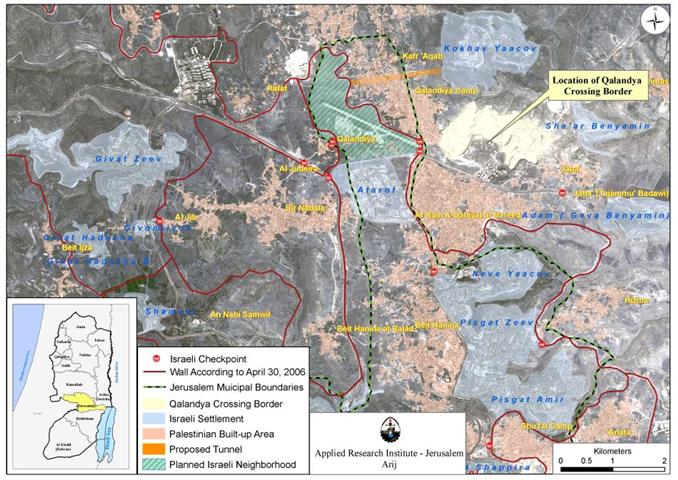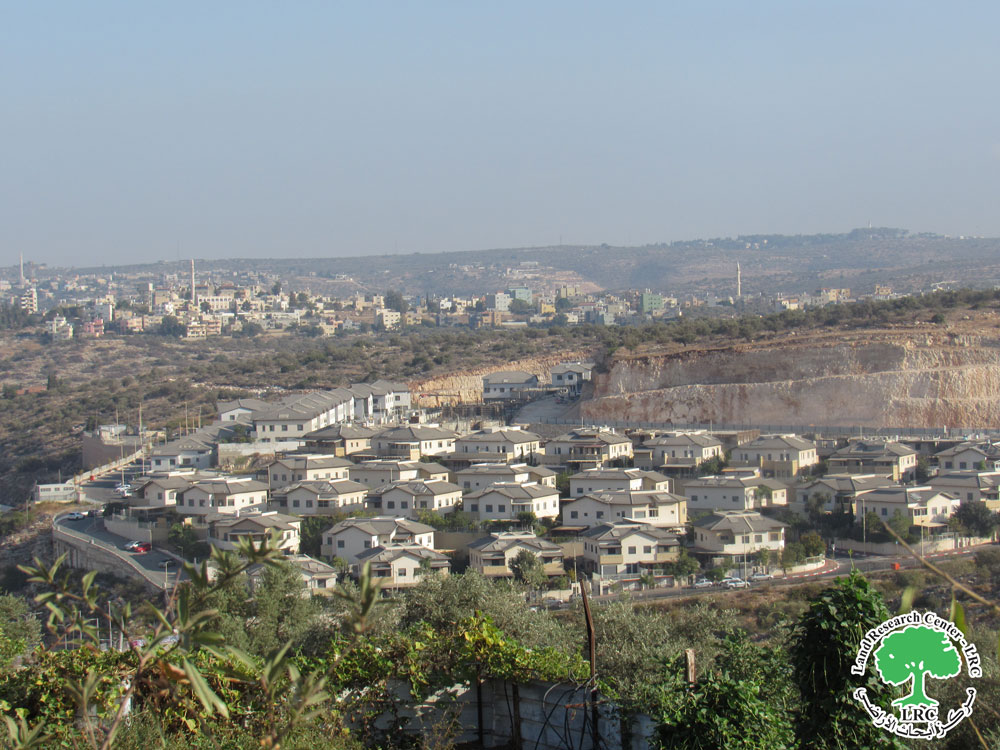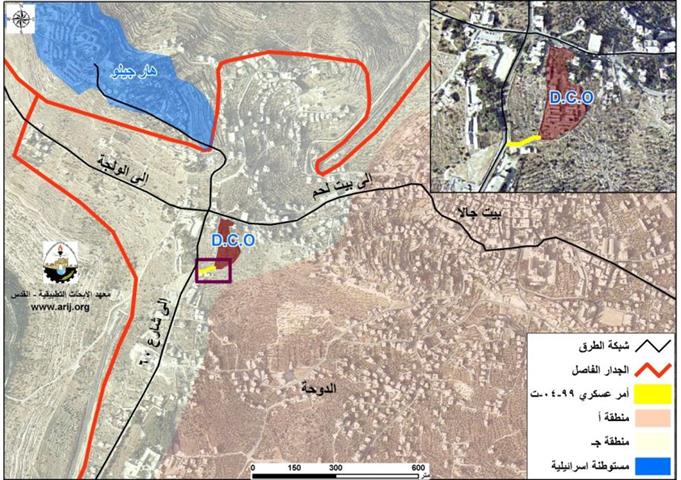On the February 28, 2007, the Israeli daily newspaper 'Haaretz' published on its website a plan submitted by the Israeli Ministry of Housing and Construction to establish a new Jewish neighborhood comprising of 11000 housing units in north of East Jerusalem. The neighborhood, according to Israeli sources, will accommodate Ultra-Orthodox settlers into the area, which come as a non-surprising step by the ministry of Housing and Construction towards the Judaization of occupied Jerusalem city.
The area designated for the establishment of the new neighborhood is located within the Israeli illegally and unilaterally redrawn Jerusalem municipal boundaries of 1967, which came on the expanse of 28 Palestinian communities surrounding Jerusalem city and resulted in the expansion of the municipal boundaries of occupied East Jerusalem city from 6.5 Km² to 71 Km². For more info, click here: 'The Geopolitical Status of Jerusalem Governorate'.
Still in preliminary planning stage
The Jewish neighborhood is planned to be constructed in densely populated area, north of Qalandiya airport within the Israeli Segregation Wall set to round the occupied city. The location of the settlement to be is south of Ramallah and Al Bireh cities, Rafat, Beir Nabal, Al Jib and Al Judera villages from the southwest and Kafr ‘Aqab and Qalandiya Camp from the east. It important to indicate at this time that the location where the Israeli settlement is set to be, has been designated as no building zone for decades, thus denying Palestinians to built and establish community on their own land, however, and once the Israeli government and the Israeli municipality of Jerusalem prepared the plans for a Jewish settlement, the classification of the area became ready for reclassification to suit the new plans and the new purposes. See Map
The plan for the new Jewish neighborhood, if approved by the Israeli Jerusalem Municipality, would be 'the largest' Jewish neighborhood to be constructed on the lands of the Illegal redrawn municipal boundary of Jerusalem city following the 1967 war as conceived by planners. In addition, the published plan indicated a proposed tunnel beneath the Palestinian village of Kafr ‘Aqab northeast of the proposed site for the new neighborhood, to be constructed in order to link the neighborhood with Israeli settlements located outside the Municipal boundaries of Jerusalem city, those sets outside the route of the Israeli Segregation Wall which Israel is construction around the city of Jerusalem (Jerusalem Envelope) such as the settlement of Kochav Yaccov, the closest Israeli settlement to the location of the projected Jewish (neighborhood) and other settlements located in the east. However, it is unlikely that the tunnel will be constructed as the proposed site for the neighborhood is connected to an Israeli controlled road that leads to settlements cluster at the east and another road at the south that leads to the heart of occupied Jerusalem and Israel.
This projected Israeli neighborhood has far more effects than it appears to be: If constructed, (1) it will establish a connection between Israeli settlements in the East (in the Jordan Valley) and those sets outside the Greater Jerusalem borders and with Israeli settlements inside the city of Jerusalem and those inside Israel. (2) the number of Israeli settlers set to reside in the planned neighborhood is considerably large; thus, increasing the number of Israeli settlers living inside Jerusalem city, and tipping the demographic balance of Jerusalem to the Israeli side; one step towards sustaining a Jewish majority in the city of Jerusalem at a time when the Israeli Segregation Wall around Jerusalem is taking entire Palestinian neighborhoods outside the city’s boundary, 8 Palestinian communities. See Map of Greater Jerusalem
'Not the First time, definitely Not the Last'
During the 40 years of occupation, Israel constructed many Jewish neighborhoods and/or settlements inside the illegal redrawn boundaries of Jerusalem Municipality to complement the consecutive Israeli governments adopted policy towards Judaization of the city. This policy was also confirmed in the Master Plan prepared by the Jerusalem Municipality ‘Jerusalem 2000 Plan’, which, among its main guidelines, called for the reinforcement of the status of Jerusalem and ensuring its continuous development as the capital of Israel and the center for the Jewish people and a sacred city for all religions; thus, giving priority in planning for the Jewish people and developing the city to be a ‘Jewish center’, while dealing with only the religious importance for ‘the other segments’ in the city. See Map
To realize its vision;
So far, since 1967, 13 Israeli locations were built inside the illegal redrawn boundaries of Jerusalem city with major impact on the land and the demography of the occupied city. Below is a detailed description of each of the neighborhoods, settlements and other industrial zone that were constructed since that time until today:
1- The Jewish Quarter inside the Old City
Immediately after the June 1967 war, Israel started to implement its colonial plans in East Jerusalem. The first move was in the Old City where the Israeli bulldozers destroyed the Moroccan Quarter, which lies adjacent to the Buraq Wall (Israel claim as “Wailing Wall”), and the courtyard of the Holy Sanctuary. Later on, Israeli religious groups settled the targeted area with the support and the protection of the Israeli Army and formed a plaza in front of the Wailing Wall for the Jewish prayers.The total area of land confiscated for this purpose was 116 dunums, an area containing more than seven hundred houses and shops, five mosques and four schools. As a result, Israel expelled more than 900 Palestinian families who were living in the Quarter.
Israel also destroyed the Sharaf Quarter, which is located at the southern part of the Old City west of the Holy Sanctuary, and expanded the Jewish Quarter from 7 dunums to 130 dunums. See Map
2- Atarot Industrial Zone
In 1970, The Israeli government established an industrial zone on lands of Qalandiya village, north of Jerusalem as part of their plan to transfer relatively polluting industrial plants to be closer to Palestinian neighborhoods. In order to achieve this goal, 1200 dunums were confiscated from both Beit Hanina and Qalandiya villages' lands and thus Atarot industrial zone came to realize. Today, Atarot covers an area of 1378 Dunums, contains more than 200 stores and factories, and is considered one of the three largest industrial zones in the West Bank along with Mishor Adumim within Ma’ale Adumim settlements bloc located east of occupied Jerusalem, and Barqan industrial zone in Nablus. The generated industrial solid waste from Atarot is often collected and dumped at the neighboring lands of Ar-Ram and Beir Nabala, affecting the neighboring lands and people. There is also an airport (Qalandiya airport) nearly which is built during the British Mandate and is strictly used by the Israeli authority. See Map
3- Neve Yacoov
Located in the northeastern side of Jerusalem city, this Israeli-Jewish settlement was built in 1972 on lands confiscated from the villages of Beit Hanina, Hizma and Ar-Ram cities. Today the settlement occupies an area of 1241 dunums and is a home to more than 30000 Israeli settlers.
4- Pisgat Zeev & Pisgat Omer
The Settlement of Pisgat Ze’ev was established in 1985 on lands confiscated from the two Palestinian villages of Beit Hanina and Hizma. Later of the same year, the settlement of Pisgat Amir was established east of Pisgat Ze’ev on the confiscated lands of the two Palestinian villages of Shu’fat and Anata. These two Israeli settlements are located in the northeastern part of Jerusalem and form a physical barrier between Shu’fat and Beit Hanina from one side and the village of Hizma, which falls outside the Israeli established Jerusalem municipal boundary on the other side, with a purpose to establish a cut-off point for the Palestinian urban expansion in Jerusalem and interrupt its continuity with other Palestinian communities in the West Bank. The two Israeli settlements occupy an area of 4062 dunums. Both Israeli settlements expand towards the north and connect with the settlement of Neve Ya’acov.
5- Rekhes Shu’fat
The settlement of Rekhes Shu’fat was established in 1990 in the northwestern part of Jerusalem on lands confiscated originally in 1970 from the Palestinian village of Shu’fat. The location where the Israeli settlement is located today was zoned by the Israeli municipality of Jerusalem as ‘green area’, where all kinds of constructions are prohibited. The settlement connects with the two settlements of Ramat Ashkol and Ramot Allon, which completely blocks the northwestern entry of Jerusalem city and connects them with West Jerusalem. The settlement occupies an area of 1625 dunums.
6- Ramot (Ramot Allon)
Ramot Allon is located in the northwestern part of Jerusalem. It is the largest of East Jerusalem Israeli settlement in terms of population, which exceeds 40,000 Israeli settlers. The Israeli authorities confiscated where the settlement stands today (4840 Dunums) from the villages of Lifta, Shu’fat and Beit Iksa in 1970. At that time, the Israeli confiscation process marked the largest of its kind from the Palestinians in East Jerusalem. It was not until 1973 that the settlement was established on area of 3383 dunums.
7- Ramot Eshkol
Ramat Ashkol is one of the first Israeli settlements constructed after the 1967 war. To that end, in 1968, the Israeli authority confiscated 2345 dunums of Palestinian lands to achieve to establish Ramat Ashkol, which formed an urban continuity with Israeli suburbs in West Jerusalem. Later on, another settlement was constructed under the name of Ma’alot Dafna, part of which was built on lands designated as “no-man’s land” according to the 1949 Armistice Line Agreement (Green Line). Today, the combined area of both Ramat Ashkol and Ma’alot Dafna is 1118 dunums.
8- French Hill
This illegal Israeli community is one of the pioneer Israeli neighborhoods Israel constructed after occupying East Jerusalem in 1967. The neighborhood was established in 1968 on confiscated lands from Lifta and Shu’fat villages, located between the Hebrew University and the settlement of Ramat Eshkol. The Israeli French Hill neighborhood closed the northern entry of Jerusalem. Today, the settlement covers an area of 688 dunums and accommodate nearly 7000 Israeli Jewish settler.
9- East Talpiot
The settlement of East Talpiot was established in 1973 on confiscated lands from the Palestinian village of Sur Baher. The land where the settlement exists today is part of 2240 dunums confiscated by the Israeli authorities in the early 1970s. The area where the settlement is located is part of the “no-man’s lands” Armistice Agreement of 1949 (Green Line). Today this settlement covers an area of 1829 dunums and is a home to 6631 Israeli settlers.
10- Har Gilo
The settlement of Har Gilo was established in 1972 on lands originally confiscated from Beit Jala and Al Walajeh Villages. Today the settlement is a home to nearly 400 Israeli settlers and occupies a total land area of 415 dunums.
11- Gilo
In 1970, the Israeli authority confiscated 2700 dunums of lands from Beit Jala, Beit Safafa, and Sharafat towns in order to build a new settlement south of Jerusalem. One year later, the Israeli bulldozers started work on the settlement of Gilo, which stands today and overshadows the city of Beit Jala at its northern side, the southern entrance of Jerusalem. Consecutive Israeli governments have expressed great interest in further development of this settlement because of its strategic location and ability for further expansion. Today, Gilo settlement has expanded on additional hundreds of dunums and is considered one of the largest Israeli settlements in the West Bank with a population exceeding 30000 Israeli settlers.
12- Abu Ghneim
Abu Ghanim Mountain is located at the northern part of Bethlehem Governorate in an area annexed to the Israeli unilaterally declared Jerusalem municipal boundary. Originally, the mountain comprised a forest and was classified ‘Green Area’. However, in the spring of 1997, when the Israel municipality of Jerusalem has finalized the process to control the mountain, including the plans of the new Har Homa settlement, the mountain area was reclassified to building zone and thus the Israeli bulldozers started annihilation process of the forest with more than 60 thousand pine trees uprooted to clear way for Har Homa settlement.
Har Homa settlement complete a series of Israeli settlements barrier (Gilo, Giv’at Hamatos and Har Homa) at the southern entrance of Jerusalem as it would block the Palestinian urban expansion in the city southwards, more than that to cut the urban continuity of East Jerusalem with the rest of the West Bank area (in this case to cut East Jerusalem from Bethlehem). Today, the settlement occupies an area of 2400 dunums and is a home to almost 4000 Israeli settlers. See Photo 1
13- Giv'at Hamatos
This settlement was established in 1991 on lands confiscated from the two Palestinian villages of Beit Jala and Beit Safafa. It is located east of Gilo settlement near the traditional main street connecting between Bethlehem and Jerusalem. Giv’at Hamatos has an area of 287 dunums and is a home to 1189 Israeli settlers.
To conclude
The establishment of Israeli settlements and neighborhoods inside the city of Jerusalem is one step adopted by the consecutive Israeli Governments ever since the Israeli occupation of the West Bank (including East Jerusalem) and the Gaza Strip.
Hague Agreement of 1907 specifies that 'it is especially forbidden- to destroy or seize the enemy's property, unless such destruction or seizure be imperatively demanded by the necessities of war.' Moreover, 'The occupying State shall be regarded only as administrator and usufructuary of public buildings, real estate, forests, and agricultural estates belonging to the hostile State, and situated in the occupied country. It must safeguard the capital of these properties, and administer them in accordance with the rules of usufruct” (Art. 55). Moreover, the Fourth Geneva Convention specifies, “The Occupying Power shall not deport or transfer parts of its own civilian population into the territory it occupies,' (article 49).
Prepared by
The Applied Research Institute – Jerusalem
ARIJ


















